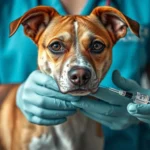
Cysts can be a common occurrence in our furry companions, often causing concern for pet owners. Understanding what cysts on dogs are, how to identify them, and the appropriate course of action can help ensure the health and well-being of your pet. Let’s delve into the details about cysts, their symptoms, diagnosis, treatment options, and preventive measures.
What Are Cysts?
Definition of Cysts
A cyst is a closed sac-like structure that can be filled with fluid, air, or semi-solid material. Cysts can develop in various tissues throughout the body, including the skin. It’s essential to distinguish between cysts on dogs and other types of skin growths, such as tumors or warts. While cysts are typically benign and non-cancerous, tumors can be malignant, making it crucial to consult a veterinarian for proper diagnosis.
Types of Cysts Common in Dogs
Several types of cysts can occur in dogs, including:
- Sebaceous Cysts: These are the most common type, originating from sebaceous glands. They often contain a thick, oily substance.
- Epidermoid Cysts: These cysts form from the outer layer of skin and can be filled with keratin.
- Follicular Cysts: These develop from hair follicles and may become inflamed and infected.
- Other Types: Less commonly, dogs may develop other cysts, such as dermoid cysts or cystic tumors.
Causes of Cysts in Dogs
The formation of cysts can be attributed to various factors, including:
- Genetic Predisposition: Some breeds are more prone to developing cysts than others.
- Skin Infections: Bacterial or fungal infections can lead to cyst formation.
- Environmental Factors: Irritants in the environment may trigger cyst development.
- Allergies and Irritants: Allergic reactions can cause skin issues, leading to cysts.
Symptoms of Cysts on Dogs
Visual Signs
Cysts can vary in appearance but often share common characteristics. Here’s what to look for:
- Size: Cysts can range from small (a few millimeters) to large (several centimeters).
- Color and Texture: They may appear as raised bumps on the skin, often with a smooth or rough texture. Color can vary from skin-toned to reddish.
- Location: Common areas for cysts include the back, neck, and ears, although they can develop anywhere on the body.
Behavioral Signs
Behavioral changes can also indicate the presence of a cyst:
- Scratching or Licking: Dogs may scratch or lick at the affected area due to irritation.
- Signs of Discomfort: If the cyst is painful, a dog may exhibit signs of discomfort, such as whimpering or reluctance to be touched.
When to Seek Veterinary Care
Monitoring your dog’s health is crucial. Here are indicators that warrant a veterinary visit:
- Rapid Growth: If a cyst seems to be growing quickly.
- Changes in Color or Texture: Any noticeable changes should be checked by a vet.
- Signs of Infection: Redness, swelling, or discharge from the cyst should prompt immediate consultation.
Diagnosing Cysts
Veterinary Examination
When you take your dog to the vet for a suspected cyst, expect a thorough examination:
- Physical Examination: The veterinarian will examine the cyst to assess its size, location, and characteristics.
- Medical History: Providing a detailed history of your dog’s health and any changes will aid in diagnosis.
Diagnostic Tests
To confirm the diagnosis and rule out other conditions, your veterinarian may recommend:
- Fine Needle Aspiration (FNA): A needle is used to extract fluid from the cyst for analysis.
- Biopsy Procedures: If the cyst’s nature is uncertain, a biopsy may be performed to evaluate the tissue.
- Imaging: In some cases, imaging techniques like ultrasounds or X-rays may be utilized to assess deeper structures.
Treatment Options
Home Care
Monitoring cysts at home can be helpful. Here are some tips:
- Regular Checks: Keep an eye on the size, color, and overall condition of the cyst.
- Topical Treatments: If recommended by your vet, apply prescribed topical treatments to soothe irritation.
Veterinary Treatments
Depending on the cyst’s nature and symptoms, various treatments may be recommended:
- Surgical Removal: If the cyst is causing discomfort or showing signs of infection, surgical removal may be necessary.
- Medications: Antibiotics may be prescribed to treat any underlying infections, while anti-inflammatories can help reduce swelling and pain.
- Alternatives to Surgery: In some cases, draining the cyst or injecting it with medication may be viable alternatives.
Post-Treatment Care
After any treatment, proper care is essential for recovery:
- Recovery Process: Follow your vet’s instructions for post-operative care, including restricting activity and monitoring the surgical site.
- Signs of Complications: Watch for excessive swelling, redness, or discharge, which could indicate complications requiring veterinary attention.
Prevention and Management
Regular Veterinary Check-ups
Regular check-ups are vital for your dog’s health. These assessments can lead to the early detection of cysts on dogs and other health issues, enabling timely interventions.
Skin Care and Hygiene
Maintaining good skin health is crucial:
- Grooming Practices: Regular brushing and bathing help remove dirt and debris that can irritate the skin.
- Diet Considerations: A balanced diet can promote healthy skin and coat. Omega fatty acids, found in fish oil supplements, can also support skin health.
Environmental Adjustments
Reducing potential allergens and irritants can help prevent cyst formation:
- Clean Living Environment: Regularly clean your dog’s bedding and living areas to minimize exposure to allergens.
- Lifestyle Changes: Consider changes that might reduce stress or irritants in your dog’s environment, such as avoiding harsh chemicals.
Frequently Asked Questions (FAQs)
Are cysts on dogs dangerous?
Most cysts on dogs are benign and not dangerous. However, some can be malignant. Regular veterinary check-ups can help differentiate between the two.
Can my dog develop a cyst at any age?
Yes, dogs can develop cysts at any age. However, older dogs may be more prone to them due to age-related factors and skin changes.
How can I differentiate between a cyst and a tumor?
Cysts are typically fluid-filled sacs, while tumors are solid masses of tissue. A veterinarian can perform diagnostic tests to make an accurate distinction.
What should I do if my dog’s cyst bursts?
If a cyst bursts, clean the area gently with mild soap and water and monitor for signs of infection. Contact your veterinarian for further advice and potential treatment options.
Conclusion
Understanding cysts on dogs is crucial for every pet owner. By recognizing the types of cysts, their symptoms, and appropriate treatment options, you can help ensure your furry friend remains healthy and happy. Regular veterinary check-ups, good hygiene practices, and monitoring changes can go a long way in managing your dog’s health. Always consult your veterinarian with any concerns regarding cysts or other health issues.









